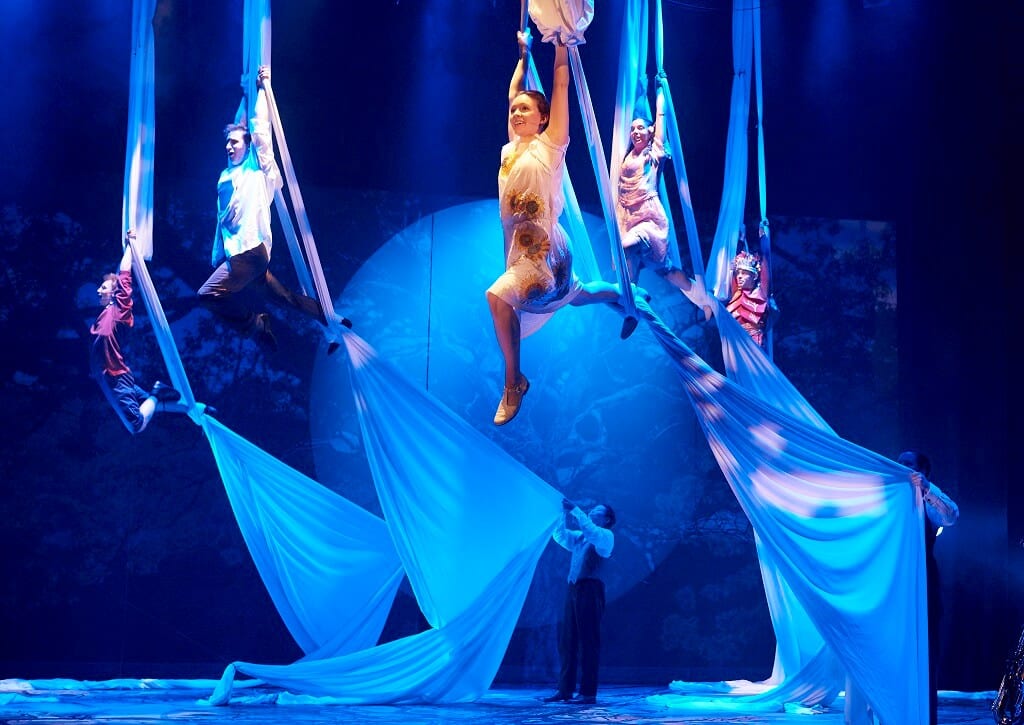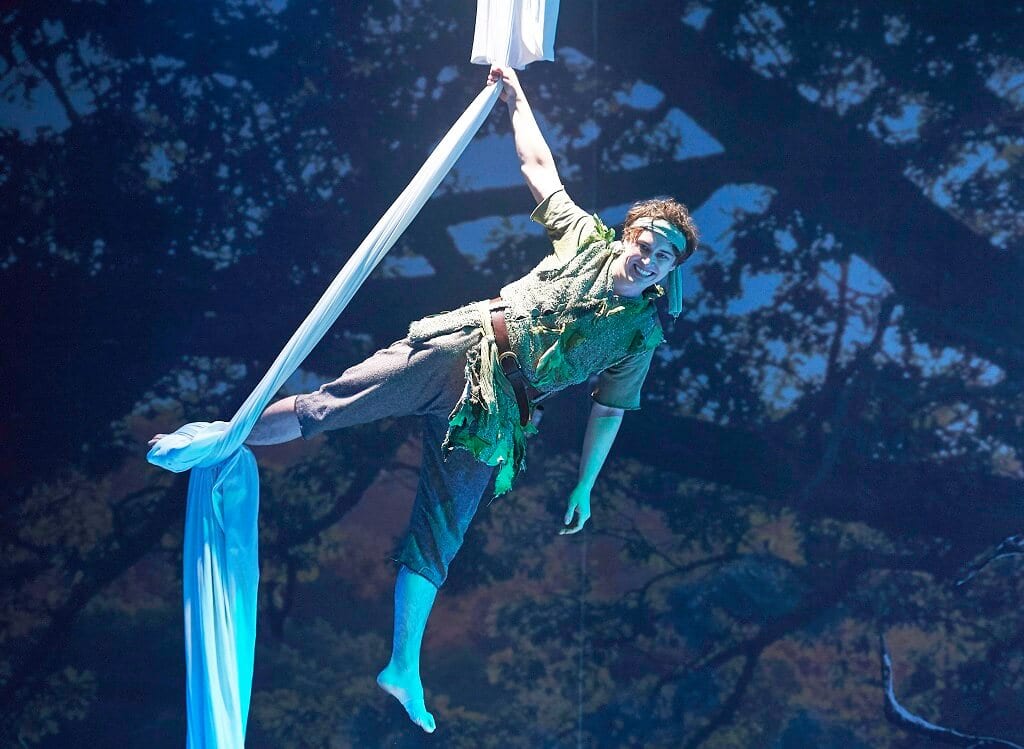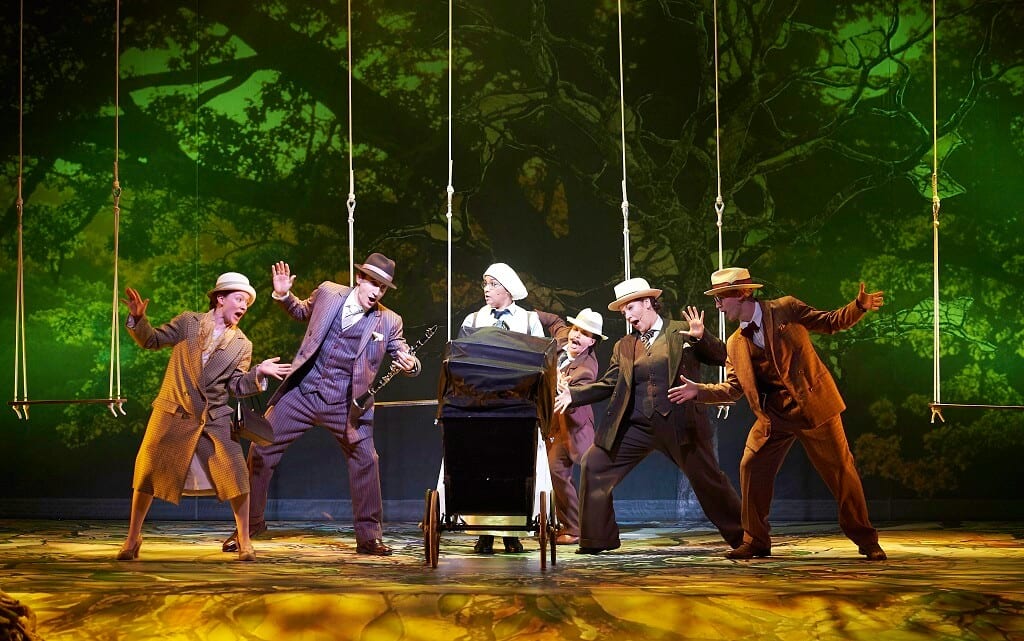Peter Pan in Scarlet is the official sequel to J M Barrie’s Peter Pan. Set in the late 1920s, that is, after World War I, the children of the original tale have all grown up now, had children themselves, and are forced by a series of dreams leaking from Neverland to return to find out what is wrong.
The play opens with a reminder of how the previous story ended; and the sense of bleak devastation caused by war and of how the dark side can grow stronger to overwhelm or haunt is terribly relevant today. The show has subtext for the grownups to consider and puzzle over if they want to engage with it; but the play itself is also a wonderful romp for children.
This is the inaugural show for the newly refurbished Oxford Playhouse, which is now a much more comfortable and attractive venue. The night I attended the audience was at least half made up of young people and they clearly not only understood what the play was about but revelled in the physicality and imaginative staging of the show. All the familiar characters are there except for Michael, who clearly has been killed in the First World War.
Though Peter has defeated his enemy, Captain Hook, he is now the captain of the Jolly Roger and wears Captain Hook’s red coat; and in taking on the role and the robe of the Captain, he takes on the identity of the wicked captain as well and begins to transform into him. He also feels abandoned, lonely, betrayed by the desertion of the children and Lost Boys back to the real world. As the play progresses Peter becomes more sinister and disturbing. Part of the pleasure of the evening is attending to revelations that I feel I must not give away.
The company is extraordinary – the show depends on imaginative and captivating acrobatics and movement and on the fact that most of the actors also double as instrumentalists. The presentation is almost circus like at times; the impressions given of flying are completely uplifting in every sense; and the use of the set is invariably imaginative making us see a rocking ship or a tough mountain to climb as required. The design by Liz Cooke is utterly praiseworthy in the extreme; the stage completely adaptable. The musical score by James Atherton supports the entire sequence of events well with an especially fine song for Wendy as she imagines a tea party. Theresa Heskins deserves top praise not only for her adaptation for the stage of the book by Geraldine McCaughrean but also for welding the company into a brilliantly versatile and energetic ensemble. Virtually every member of the cast plays an instrument, has more than one part, and morphs into the different roles or moments as members of the musical ensemble with ease and speed. This is a swift moving show that keeps the attention and delight of the audience by its vitality, both dramatic and visual.
Isaac Stanmore is simply perfect as Peter (and a Nursemaid and a Waiter and on Guitar and on Drums), capturing the boyishness at the start and developing into a darker and more troubling character as the play progresses. Rebecca Killick conveys both Wendy’s maternal games playing and a genuine emotional depth. I was especially struck by Suzanne Ahmet as Tootles, Jonathan Charles as Slightly, and Michael Hugo as Fireflyer. The “Ravello” of Andrew Pollard is perfect in both its burlesque and its more sinister aspects. Praise must also be given to James Atherton’s own work on stage at the keyboard and as a percussionist.
This is the best kind of theatre, stimulating the imagination with what you see so that what you get becomes much more. There is plenty here for the grownups to enjoy in the skills of the performers, the imagination of the setting and the way the story is told; and in the darker implications. And if you have children aged anything from about six to sixteen, this is as good an experience as attending the best kind of pantomime and there is a very satisfying ending that might be clearly enough telegraphed to the adults from an early stage in the proceedings but will still be a fine coup de theatre for youngsters.





